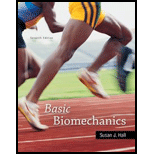
Concept explainers
To explain: The reason why the bones of the human body are stronger in resisting compression than in resisting tension and shear.
Introduction: Bones provide the structural framework for human body, protects other body tissues, and forms a system of levers for purpose of movement along with muscles. Bones are subjected to a lot of forces like compression, tension and shear force.
Explanation of Solution
The bone is made of collagen, hydroxypatite, calcium carbonate and calcium phosphate.
The following is the resistance strength of bone to forces:
- Bone is strong against compression
- Bone is intermediate against tension
- Bone is weak against shear
Compression is the force that pushes or presses the bone. Tensile force acts on the bone and pulls in opposite direction. Shear forces act parallel to each other but in the opposite direction on the object so that one part of the object (bone) is displace relative to another part.
About 60-70% of the bone is made up of the minerals, calcium carbonate and calcium phosphate. They give stiffness to bones and constitute the primary determiners of compressive strength and thus they have strong resistance against compression. The second material is collagen, a protein that constitutes about 20 to 30% of the bones which gives bones its flexibility and thus the resistance against tensile force. The bones are not made of materials to withstand shear force and therefore, it has weak resistance against shear force.
Want to see more full solutions like this?
Chapter 4 Solutions
Basic Biomechanics
- Describe the two types of cartilaginous joints and give examples of each.arrow_forwardWatch this video (http://openstaxcollege.org/l/fractures) to see how fractures of the distal radius bone can affect the wrist joint. Explain the problems that may occur if a fracture of the distal radius involves the joint surface of the radiocarpal joint of the wrist.arrow_forwardA bursa ________. surrounds a tendon at the point where the tendon crosses a joint secretes the lubricating fluid for a synovial joint prevents friction between skin and bone, or a muscle tendon and bone is the strong band of connective tissue that holds bones together at a synovial jointarrow_forward
- The elbow is an example of which type of joint? hinge pivot saddle glidingarrow_forwardFigure 38.19 Which of the following statements about bone tissue is false? Compact bone tissue is made of cylindrical osteons that are aligned such that they travel the length of the bone. Haversian canals contain blood vessels only. Haversian canals contain blood vessels and nerve fibers. Spongy tissue is found on the inferior of the bone, and compact bone tissue is found on the exterior.arrow_forwardDefine how joints are classified based on function. Describe and give an example for each functional type of joint.arrow_forward
- At a synovial joint, the synovial membrane ________. forms the fibrous connective walls of the joint cavity is the layer of cartilage that covers the articulating surfaces of the bones forms the intracapsular ligaments secretes the lubricating synovial fluidarrow_forwardA cartilaginous joint ________. has a joint cavity is called a symphysis when the bones are united by fibrocartilage anchors the teeth to the jaws is formed by a wide sheet of fibrous connective tissuearrow_forwardA meniscus is ________. a fibrocartilage pad that provides padding between bones a fluid-filled space that prevents friction between a muscle tendon and underlying bone the articular caililage that covers the ends of a bone at a synovial joint the lubricating fluid within a synovial jointarrow_forward
- A syndesmosis is ________. a narrow fibrous joint the type of joint that unites bones of the skull a fibrous joint that unites parallel bones the type of joint that anchors the teeth in the jawsarrow_forwardThe Haversian canal: is arranged as rods or plates contains the bone’s blood vessels and nerve fibers is responsible for the lengthwise growth of long bones synthesizes and secretes matrixarrow_forwardWatch this video (http://openstaxcollege.org/l/colles) to learn about a Colles fracture, a break of the distal radius, usually caused by falling onto an outstretched hand. When would surgery be required and how would the fracture be repaired in this case?arrow_forward
 Anatomy & PhysiologyBiologyISBN:9781938168130Author:Kelly A. Young, James A. Wise, Peter DeSaix, Dean H. Kruse, Brandon Poe, Eddie Johnson, Jody E. Johnson, Oksana Korol, J. Gordon Betts, Mark WomblePublisher:OpenStax College
Anatomy & PhysiologyBiologyISBN:9781938168130Author:Kelly A. Young, James A. Wise, Peter DeSaix, Dean H. Kruse, Brandon Poe, Eddie Johnson, Jody E. Johnson, Oksana Korol, J. Gordon Betts, Mark WomblePublisher:OpenStax College Biology 2eBiologyISBN:9781947172517Author:Matthew Douglas, Jung Choi, Mary Ann ClarkPublisher:OpenStax
Biology 2eBiologyISBN:9781947172517Author:Matthew Douglas, Jung Choi, Mary Ann ClarkPublisher:OpenStax
 Biology: The Dynamic Science (MindTap Course List)BiologyISBN:9781305389892Author:Peter J. Russell, Paul E. Hertz, Beverly McMillanPublisher:Cengage Learning
Biology: The Dynamic Science (MindTap Course List)BiologyISBN:9781305389892Author:Peter J. Russell, Paul E. Hertz, Beverly McMillanPublisher:Cengage Learning





